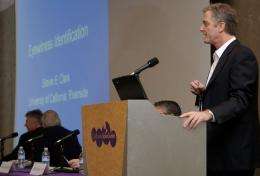Eyewitness identification reforms may have unintended consequences

(Medical Xpress) -- New research by a University of California, Riverside psychologist raises serious questions about eyewitness identification procedures that are being adopted by police departments across the United States.
These new procedures are designed to reduce the kinds of false identification errors that can lead to wrongful convictions of innocent people.
While it has long been held that these changes reduce false identifications with little or no loss of correct identifications, UC Riverside psychology professor Steven E. Clark suggests that that is not the case.
The loss of correct identifications can be significant, Clark says. Importantly, the new procedures may, under some circumstances, lead to identification evidence that is less accurate than the identification evidence from the procedures they are designed to replace. Policymakers need to look very carefully at the data from empirical studies as they consider adopting new procedures, he cautions.
Clark’s study, “Costs and Benefits of Eyewitness Identification Reform: Psychological Science and public Policy,” appears in the May issue of the peer-reviewed journal Perspectives on Psychological Science, published by the Association for Psychological Science. It can be viewed online.
Clark has been involved in more than 200 criminal and civil cases, has consulted with prosecution and defense attorneys, and has testified as an expert in federal and state courts in six states, including California. Much of his research has been funded by the National Science Foundation.
In the paper, the psychologist notes that the reforms are directed at fundamental aspects of the identification process: How lineups are constructed, what witnesses are told and how they are instructed prior to the lineup, the way that the lineup is presented, and what police officers should and should not say and do during the identification procedure.
“Whether policymakers decide to adopt or not adopt these new procedures is up to them,” he says. “In order to make those policy decisions, they need to know clearly what the benefits are and what the costs are.”
For some of the new procedures the cost-benefit trade-offs are clear. For other procedures, Clark suggests that the critical research has not been done. For example, one of the new procedures coming into use requires that the police officer who shows the lineup not know which person in the lineup is the suspect. In this “blind” procedure, the police officer would not know whether the suspect was second, third or sixth in the lineup. The blind procedure prevents police officers from deliberately or inadvertently cuing witnesses about who they should pick from the lineup.
“The principle behind blind lineup administration is solid,” Clark says. “If the criminal justice system is concerned that the police might inadvertently communicate their expectations to witnesses, then a good solution is for the police to not have expectations by not knowing which person in the lineup is the suspect. However, many ideas that seem right in principle don’t actually work, or have unintended side effects. The principle behind the blind lineup may be solid, but solid data would be better.”
Clark’s research examines the results from dozens of eyewitness identification studies that have been conducted and published over the last 32 years. The trade-off between false identifications avoided versus correct identifications lost is consistent, he says.
This trade-off raises an important question: How many correct identifications is the justice system willing to lose in order to avoid a false identification? Clark explains that under some conditions that trade-off may be as high as 100 correct identifications lost for each false identification avoided.
Is that a trade-off that the criminal justice system is willing to accept? It depends, Clark says.
“In our justice system there is a view that a false conviction is a far worse error than a false acquittal,” he says. “However, false identifications do not always lead to prosecution or false convictions, and false nonidentifications do not always lead to false acquittals. This raises a question about the justice system’s ability to correct its mistakes.
“Whether the justice system prefers one eyewitness identification procedure over another depends on many factors, the nature of the trade-off — for example, how many correct identifications are lost in exchange for each false identification that is avoided — and what the consequences of those errors are. There are many other considerations as well, in terms of due process and procedural justice. Policymakers have a lot to chew on.”















